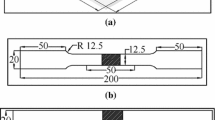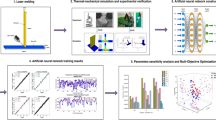Abstract
The present work deals with modeling and optimization of ultrasonic welding (USW) process parameters including welding time, pressure, and vibration amplitude influencing strength of the welded parts of acrylonitrile butadiene styrene (ABS) and poly(methyl methacrylate) (PMMA) using artificial intelligence (AI) methods. Experiments performed on samples by spot welding workpieces of ABS and PMMA. The experimental data are used for training of artificial neural networks (ANN), adaptive neuro-fuzzy inference systems, and hybrid systems. It is found that ANN had better predictions compared with the other AI methods. The best model was a feed-forward back-propagation network, with uniform transfer functions (TANSIG–TANSIG–TANSIG) and 4/2 neurons in the first/second hidden layers. The best predictor is then presented to genetic algorithm (GA) and particle swarm optimization (PSO), as the fitness function and for optimizing the USW machine parameters. After the optimization, results of this part revealed that GA and PSO have comparable results and the calculated strength increased by 10%, as compared with a non-optimized case. In order to confirm the computational results, validating experiments are performed which their outputs demonstrates good agreement with the optimization result.
Similar content being viewed by others
References
Troughton MJ (2008) Handbook of plastic joining: a practical guide, 2nd edn. Plastics Design Library, Norwich, NY
Devin J (1981) Ultrasonic plastic welding basics. Welding Journal 29–33
Kamiya A, Ovaska S, Roy R, Kobayashi S (2005) Fusion of soft computing and hard computing for large-scale plants: a general model. Appl Soft Comput 5(3):265–279
Kayak O, Zadeh L (1998) Fuzzy inference systems: a critical review, computational intelligence soft computing and fuzzy-neurointegration with applications. Springer, Berlin
Pradhan MK, Biswas CK (2010) Neuro-fuzzy and neural network-based prediction of various responses in electrical discharge machining of AISI D2 steel. Int J Adv Manuf Technol 50:591–610
Lee ZJ, Ying KC, Chen SC, Lin SW (2010) Applying PSO-based BPN for predicting the yield rate of DRAM modules produced using defective ICs. Int J Adv Manuf Technol 49:987–999
Tavakkoli-Moghaddam R, Azarkish M, Sadeghnejad-Barkousaraie A (2010) Solving a multi-objective job shop scheduling problem with sequence-dependent setup times by a Pareto archive PSO combined with genetic operators and VNS. Int J Adv Manuf Technol. doi:10.1007/s00170-010-2847-4
Costa A, Celano G, Fichera S (2010) Optimization of multi-pass turning economies through a hybrid particle swarm optimization technique. Int J Adv Manuf Technol. doi:10.1007/s00170-010-2861-6
Ghosal S, Chaki S (2010) Estimation and optimization of depth of penetration in hybrid CO2 LASER-MIG welding using ANN-optimization hybrid model. Int J Adv Manuf Technol 47:1149–1157
Sha DY, Hung Lin H (2009) A particle swarm optimization for multi-objective flowshop scheduling. Int J Adv Manuf Technol 45:749–758
António CAC, Davim JP, Lapa V (2008) Artificial neural network based on genetic learning for machining of polyetheretherketone composite materials. Int J Adv Manuf Technol 39:1101–1110
Sarkar S, Mitra S, Bhattacharyya B (2006) Parametric optimisation of wire electrical discharge machining of titanium aluminide alloy through an artificial neural network model. Int J Adv Manuf Technol 27(5):501–508
Lee WM, Liao YS (2007) Adaptive control of the WEDM process using a self-tuning fuzzy logic algorithm with grey prediction. Int J Adv Manuf Technol 34(5):527–537
Kirkland TR (2001) The implications of the fundamental formulas for frequency selection in ultrasonic plastics welding. In: 31st annual symposium of Ultrasonic Industry Association Atlanta, Georgia, USA,
Tsujino J, Hongoh M, Yoshikuni M, Hashii H, Ueoka T (2004) Welding characteristics of 27, 40 and 67 kHz ultrasonic plastic welding systems using fundamental- and higher-resonance frequencies. Ultrasonics 42(1–9):131–137
Alejandro A. Espinoza JER (2004) An optimization study of the ultrasonic welding of thin film polymers. In: Proceedings of DETC 04 ASME 2004.
Michaelia W, Haberstrohb E, Hoffmann WM (2008) Ultrasonic welding of micro plastic parts. Multi-material micro manufacture. Cardiff University, Cardiff, UK
Hagan MT, Menhaj MB (1994) Training feed forward networks with the marquardt algorithm. IEEE Transactions on Neural Networks 5(6):989–993
Jang JSR (1993) ANFIS: Adaptive-Network-based fuzzy inference systems. IEEE Transactions on Systems, Man, And Cybernetics 23(3):665–685
Rajasekaran S, Pai GAV (2005) Neural networks, fuzzy logic, and genetic algorithms synthesis and application. Prentice-Hall, New Delhi
Li T-S, Hsu C-M (2010) Parameter optimization of sub-35 nm contact-hole fabrication using particle swarm optimization approach. Expert Syst Appl 37(1):878–885
Majhi B, Panda G (2011) Robust identification of nonlinear complex systems using low complexity ANN and particle swarm optimization technique. Expert Syst Appl 38(1):321–333
Goldberg DE (1989) Genetic algorithm in search optimization and machine learning. Addison-Wesley, Boston, MA
Xing WX (1998) Modern optimization algorithm. Tinghua University Press, Beijing
Eberhart RC, Shi Y (2001) Particle swarm optimization development, applications and resources. In: Congress on Evolutionary Computation, Piscataway, NJ. IEEE Press, pp 81–86
Kennedy J, Eberhart R (1995) Particle swarm optimization. In: IEEE International Conference on Neural Networks, Perth, WA, Australia. IEEE Service Center, pp 1942–1948
AWS (2006) Guide to ultrasonic assembly of thermoplastics. G1.1M/G1.1. American Welding Society, Miami
Myatt GJ (2007) Making sense of data a practical guide to exploratory data analysis and data mining. Wiley, Hoboken, NJ
Trenn S (2008) Multilayer perceptrons: approximation order and necessary number of hidden units. IEEE Transactions On Neural Networks 19(5):836–844
Nakamura M, Mines R, Kreinovich V (1993) Guaranteed intervals for Kolmogorov’s theorem (and their possible relation to neural networks). Interval Computations 3:183–199
Sapuan SMMI (2010) Composite materials technology neural network applications. CRC Press, Florida
Guo WW (2010) A novel application of neural networks for instant iron-ore grade estimation. Expert Syst Appl 37(12):8729–8735
Mohanty JRVB, Parhi DRK, Ray PK (2009) Application of artificial neural network for predicting fatigue crack propagation life of aluminum alloys. Archives of Computational Materials Science and Surface Engineering 1:133–138
Atik K, Aktas A, Deniz E (2010) Performance parameters estimation of MAC by using artificial neural network. Expert Syst Appl 37(7):5436–5442
Jung J-R, Yum B-J (2011) Artificial neural network based approach for dynamic parameter design. Expert Syst Appl 38(1):504–510
Khosravi A, Nahavandi S, Creighton D (2010) A prediction interval-based approach to determine optimal structures of neural network metamodels. Expert Syst Appl 37(3):2377–2387
Ashrafi HR, Jalal M, Garmsiri K (2010) Prediction of load-displacement curve of concrete reinforced by composite fibers (steel and polymeric) using artificial neural network. Expert Syst Appl 37(12):7663–7668
Swingler K (1996) Applying neural networks: a practical guide. Academic Press, San Diego, CA
Adineh VR, Aghanajafi C, Dehghan GH, Jelvani S (2008) Optimization of the operational parameters in a fast axial flow CW CO2 laser using artificial neural networks and genetic algorithms. Optics & Laser Technology 40(8):1000–1007
Kasabov NK (1998) Foundations of neural networks, fuzzy systems and knowledge engineering. A Bradford book, 2nd edn. MIT Press, Cambridge, MA
Kermani BG (2007) Modeling oligonucleotide probes for SNP genotyping assays using an adaptive neuro-fuzzy inference system. Sensors and Actuators B 121:462–468
Stephen LC (1996) Selecting input variables for fuzzy models. J Intelligent & Fuzzy Systems 4(4):243–256
Jang JSR (1996) Input selection for ANFIS learning. In: The IEEE international conference on fuzzy systems, New Orleans, LA, USA. pp 1493–1499
Das A, Maiti J, Banerjee RN (2010) Process control strategies for a steel making furnace using ANN with bayesian regularization and ANFIS. Expert Syst Appl 37(2):1075–1085
Brige B TPSOt (2003) A particle swarm optimization toolbox for use with matlab. In: Proceedings of the 2003 IEEE swarm intelligence symposium, Indianapolis, Indiana, USA. pp 182–186
Deemuth H, Beale M, Hagan M (2007) Neural network toolbox 5 user’s guide. The Mathworks Inc., Natick, MA
Mendi F, Baskal T, Boran K, Boran FE (2010) Optimization of module, shaft diameter and rolling bearing for spur gear through genetic algorithm. Expert Syst Appl 37(12):8058–8064
Goldberg DE (2002) The design of innovation. Kluwer, Norwell
Evers GI, Ghalia MB (2009) Regrouping particle swarm optimization: a new global optimization algorithm with improved performance consistency across benchmarks. In: IEEE international conference on systems, man, and cybernetics, San Antonio, TX. pp 3901–3908
Yoshida H, Kawata K, Fukuyama Y, Nakanishi Y A (1999) Particle swarm optimization for reactive power and voltage control considering voltage stability. In: Proc. Int. Conf. Intell. Syst. Appl. Power Syst., Rio de Janeiro, Brazil. pp 117–121
Trelea IC (2003) The particle swarm optimization algorithm: convergence analysis and parameter selection. Inf Process Lett 85:317–325
Clerc M (2006) Particle swarm optimization. British Library Cataloguing-in-Publication Data
Bergh FVD (2002) An analysis of particle swarm optimizers. Department of Computer Science, University of Pretoria, Pretoria, South Africa
Jiang M, Luo YP, Yang SY (2007) Particle swarm optimization—stochastic trajectory analysis and parameter selection. In: Felix TSC (ed) Swarm intelligence focus on ant and particle swarm optimization. I-TECH Education and Publishing, Wien
Author information
Authors and Affiliations
Corresponding author
Rights and permissions
About this article
Cite this article
Norouzi, A., Hamedi, M. & Adineh, V.R. Strength modeling and optimizing ultrasonic welded parts of ABS-PMMA using artificial intelligence methods. Int J Adv Manuf Technol 61, 135–147 (2012). https://doi.org/10.1007/s00170-011-3699-2
Received:
Accepted:
Published:
Issue Date:
DOI: https://doi.org/10.1007/s00170-011-3699-2




